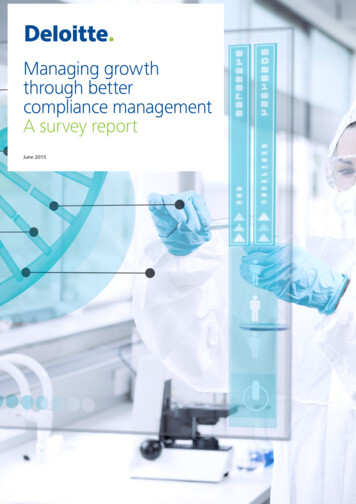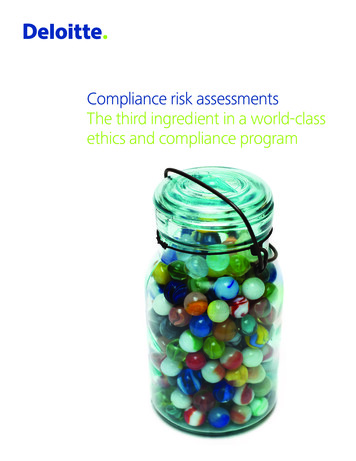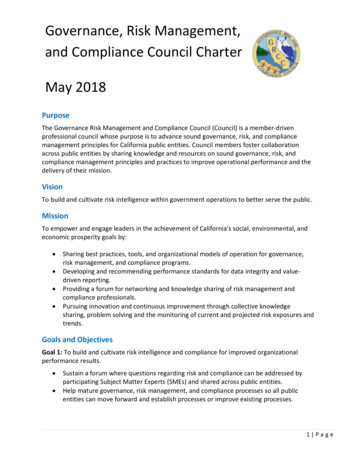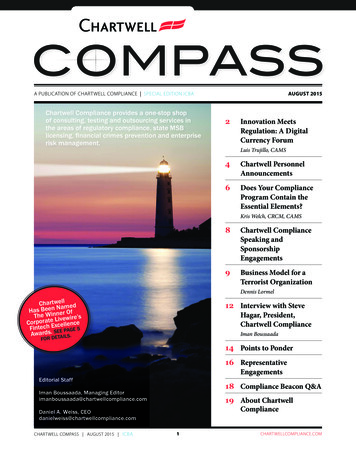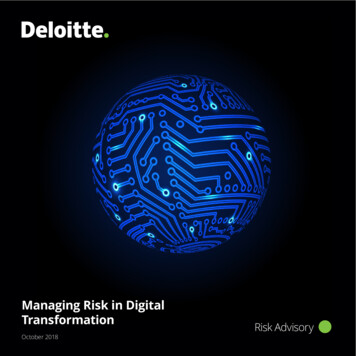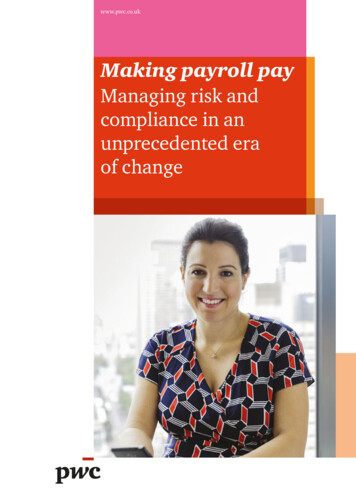
Transcription
www.pwc.co.ukMaking payroll payManaging risk andcompliance in anunprecedented eraof change
Global megatrendsDemographicand socialchangeShift in globaleconomic powerRapidurbanisationClimate changeand resourcescarcityThe world is changing. Major economic, cultural, social and scientific changes arehaving a significant impact in the world. These changes are known as megatrends.PwC’s Network Leadership identified five megatrends that will impact the future ofboth PwC and its clients over the next decade and reshape the global marketplace.We believe these megatrends will impact the payroll function and process.2 Making payroll pay PwCTechnologicalbreakthroughs
ContentsOverview4Globalisation and the impact on payroll operations5Payroll technology in the digital age8Risk, regulation and compliance10Making payroll pay12Contacts13
Payroll errors cost theaverage FTSE 100 companybetween 10M and 30M perannum. Tax legislation inthe UK requires a Boardmember or Officer of thecompany to take personalresponsibility for thecompany’s tax reporting.More legislative change is onthe way, including theintroduction of individualtaxpayer accounts and themove to payroll of benefits inkind. Isn’t it time you took acloser look at your payroll?OverviewThe objective for payroll has alwaysbeen a simple one – pay your employeesaccurately and on time. Payroll hashistorically been seen as a low riskfunction, generally automated (oroutsourced) and where issues rarelytrouble the higher levels ofmanagement. To that extent youprobably haven’t given it a great deal ofmanagement time or attention. Thatneeds to change because employmenttaxes are now globally the largestsource of government income,contributing on average 38% of thetotal tax take, and its coming undergovernment and tax authority scrutinylike never before.Tax authorities increasingly see thepayroll function as their primary taxcollection agent, transferring an evergreater burden of responsibility onemployers particularly when set againstthe backdrop of continuous legislativeand regulatory changes. Globalmegatrends such as technologicalbreakthroughs, rapid urbanisation,4 Making payroll pay PwCdemographic shifts and social changesare combining to drive radical changes inthe way we live our lives. For example: How, where, when and for whomwe work. How, where and when we accessinformation. How organisations use technologyto record, analyse and report data.This means employment turnover ratesare higher than ever before as is greaterworkforce mobility and flexibility – allputting an increased strain on thetracking of accurate data for payrollreporting.Organisations need to face up to thechallenges facing payroll. The financialand reputational risks of processingpayroll late and/or incorrectly, notadhering to evolving data privacy andprotection regulations and thedisconnect between finance, HR andpayroll systems, create a countdown toa potential disaster.In this paper we look at the payrollfunction and process through anumber of lenses based upon theexternal challenges that organisationscurrently face. Globalisation and the impact onpayroll operations. Payroll technology in the DigitalAge. Risk management. Regulation and Compliance.These challenges may be replicated inmany locations so our view and how wehelp our clients is not confined to the UK.Our focus is not simply on the complianceaspects of the payroll process but makingsure that the payroll function has stronggovernance and controls, supported bythe right technology.
Globalisation and the impact onpayroll operationsAs organisations increasingly look beyond domestic boundaries, so the complexity of their payroll operations grow. In arecent PwC survey of 193 organisations, 89% expect international mobility to increase, but much of this will be throughshort term assignments and international business travellers, rather than more traditional long term assignments. Trackingindividuals to determine taxability on a country by country basis is already one of the hardest challenges that organisationsface in order to be fully compliant with tax withholding rules.Global mobility adds complexity to the payroll processAssignments, secondments, dual contracts,split payroll, business travellersCurrency translation/split paymentsLate reported payments, corrections andtrailing incomeWithholding, reporting and depositrequirements and exceptionsCompensation, capture/collectionComplex computations including gross upsPwC Making payroll pay 5
As emerging market economies evolve,so does the level of payroll taxsophistication. This is evidenced by thegrowth in social security systems andemergence of Provident Funds incountries such as Brazil, China andIndia. At the same time, organisationsare increasingly dealing with changedworkforce demographics and flexedworking arrangements. Employees onzero hours contracts, contractors,part-time and job sharing arrangementsall place additional burden on the payrollfunction. Who they are responsible forpayment to, how much should be paidand for which period of time? This ismade more complex when these workpatterns extend across geographicboundaries.The movement to Real TimeInformation (RTI) reporting in the UK,requires employers to gather details offoreign paid compensation as it isdelivered in the home locationoverseas. While the UK HMRC providesa relaxation to the RTI system in the UKwhere the employer registers aModified PAYE arrangement, this typeof more ‘relaxed’ PAYE system has notbeen replicated by other countries.Therefore, the pressure remains togather data in real time for processingacross multiple jurisdictions. In Africa,payroll is the source of tax filing data inmany countries – i.e. individuals do notfile tax returns, so if the payroll isn’tright, it’s the employer who will beaudited by the tax authority.Global payroll challengesIncreased level of tax audits and notices(both corporate and individual)More evidence oflinks formingbetween tax andimmigrationauthoritiesExchange ofinformationagreements intax treaties beingused forindividual taxcomplianceEmerging markets –assessments and audits basedupon recharged values – not onactual costs1Move to usingemployer datadirectly topre-populateemployee taxreturnsTax transparencycreates visibilityon any failure tocorrect tax andsocial securityNon-recoverable overpaymentsto tax authorities – ensure youget the sums right!Moving People with Purpose – Modern Mobility Survey, PwC, October 20146 Making payroll pay PwCTargeted audits(e.g. frequentbusinesstravellers)UK Real time PAYEreporting andenhanced penaltyregime createsSAO andgovernance issues
Questions to ask How do you currently identify andtrack internationally mobileemployees? How do you know when frequentbusiness travelers have triggeredwithholding tax thresholds? As your international operationshave grown have you developed amulti territory payroll strategy(e.g. retained a single globalprovider, or are you managing anetwork of local providers)? How do you deal with multicurrency arrangements? How do you deal with ModifiedPAYE arrangements in the UK andshadow payroll arrangementsoutside the UK – and where youbear the tax on behalf of youremployees, is the tax and socialsecurity contribution beingengrossed correctly?Our viewOrganisations are struggling with the increasing complexity and globalnature of payroll. Compliance is a key driver, particularly for clients wherethey have small employee populations outside their key establishedlocations. Managing payroll for mobile employees and dealing with crossborder issues needs payrolls to be managed in a coordinated way, such thathome and host country issues can be addressed simultaneously.PwC Making payroll pay 7
Payroll technology in the digital ageRapidly advancing technology in the Digital Age means organisations are increasingly moving theirtechnology away from ERP based systems to cloud based solutions.In the past, digital meant ecommerce.But the landscape has changed; therapid rise of social media, smartdevices, big data and cloud computinghas opened up avenues forimprovement. At the same time,employees are changing throughdemographic change, increasedexpectations and empowerment.Technology and social media aremaking employees better informed,more connected and more vocal – gettheir payroll wrong and with the powerof social media you and the wider worldwill very quickly get to know about it!For many organisations the payrollsystem (or interface with an outsourceproviders system) remains separatefrom the HR and finance systems whichdrive payroll inputs and manage theoutputs. Very few organisations areoperating cloud based payroll systems,interlinked with their other cloudplatforms. Confidential data may bepassed via email or other non-securedata exchanges.With an increasing number of payrollsystems available, organisations arefaced with difficult decisions inselecting the right fit for the business.Making the right decision based on theorganisation’s risk appetite,understanding of the broader IT andbusiness strategy is vitally importantfor payroll systems.Having good data is increasinglyimportant to ensure good governanceand control over systems and processes.At the same time, your employeesexpect you to act responsibly with theirpersonal information and to respecttheir right to privacy. UK DataProtection Act and forthcomingEuropean Data Regulation lawdemands this too. Failure to complywith the law can lead to serious legaland financial consequences andsignificant operational challenges, suchas business disruption, financial lossand damage to brand and reputation.Managing your cost base – traditionallypayroll systems have been managedthrough the in-house IT teams. Withincreasing dependencies onoutsourcing and use of emergingtechnologies such as Cloud,organisations are moving from a Capexto Opex model where billing isperformed by the provider. This placesan increased reliance on the provider toensure billings are performedaccurately.Digital technology trendsSocialMobileAnalyticsCloud In emerging markets itis much more commonfor employees toopenly share details oftheir compensation Payslips sent to mobiledevices Ability to producemeaningful informationfrom significantvolumes of data Data privacy issues –who can access compdata and from where?8 Making payroll pay PwC Real time compreporting – see it as ithappens How does payrollcommunicate withother systems
Questions to ask Does your current payroll systemfit into your overall technologystrategy? Have you analysed the cost ofrunning your global payrollsystems and number of vendors? If your HR system is cloud based– what interface do you have toyour payroll system and how dothe outputs link to your financesystem? Do you have confidence that youroutsource provider can deliver anend to end payroll solution? Is your payroll data secure andhave you performed penetrationtesting or tested ISO compliancewith ISO 27001 (whether youoperate the payroll internally orvia an outsource provider)? How can you take advantage ofcloud technology to enable a moreresilient and efficient payrollenvironment?Our viewHaving a coherent technology strategy is critical to deal with the increasedcomplexity of payroll operations and the increased compliance and regulatoryenvironment. The top three criteria for selecting a global payroll vendor arecost, geographic/global capability and technology platform. Often the decisionto implement a system is made based upon cost alone, without thought to howthe technology will fit with broader technology strategy.PwC Making payroll pay 9
Risk, regulation and complianceIt remains rare for a payroll system tofail completely, but there have beenwell publicised examples of companiesfailing to process their payroll on atimely basis and the consequent impactacross the workforce. With increasedtechnology and complexity comes thegreater risk that your payroll team willnot be able to keep up with all of thetechnical and regulatory changesaffecting them. It is estimated thatannually, there are more than 35,000tax and social security logic and otherparameter changes needed to operatepayroll in compliance with localregulations around the world. For anorganisation operating in multiplejurisdictions, that is a significant numberof changes that need to be made tosystems and possibly processes as well.Two examples of this changed approachwhich is increasing the burden onemployers:Tax authorities increasingly regard theemployer as their tax agent,transferring the obligation to collectand account for taxes and socialsecurity contributions in real time.In addition many more countries(including several US state taxauthorities) are moving towards realtime filing, electronic deposit andcollection of taxes, with significantly HMRC in the UK is taking the firststeps in extending PAYE to thecollection of tax on non-cashbenefits in kind from April 2016 andhas announced the replacement ofthe Self Assessment tax system withdigital taxpayer accounts within thenext five years. Nordic countries are publishing taxreturns online for all citizens whichmeans employer providedcompensation data is publicallyavailable and needs to be accurate(in Denmark 98% of the populationare no longer required to file atax return).increased penalties for inaccuracy.With further changes on the horizon,many organisations are reaching atipping point in terms of their ability tokeep up with and accommodate morechanges. Investing time now to reviewthe capacity and capability of yourpayroll function will ensure it isresilient enough to deal with theseongoing changes.From an internal perspective,organisations are struggling to obtainvisibility of the end-to-end payrollprocesses and effectiveness of controls,and find it challenging to maintainclarity in the roles and accountabilities.Having a comprehensive understandingof the payroll related risks to theorganisation and defining how toaddress those risks through an effectivepayroll governance framework, iscentral to building a sustainable andresilient payroll function.Understanding payroll risks Roles, responsibilities andaccountabilities of:–– payroll team–– non-payroll teams andcorporate functions–– overseas supportfunctions. Ensuring appropriateskills, qualifications andtraining of payroll staffand those involvedthroughout the process.PeopleProcessPayrollGovernance IT general controls overpayroll systems andsupporting infrastructure. Automated vs manualprocesses and controls. How the payroll systemsexchange data with:–– ERP/Finance system–– 3rd party processingand reporting systems.10 Making payroll pay PwCTechnologyCompliance Understanding anddocumenting the end to endpayroll processes. Identifying gaps in controls. Monitoring and review controls. Segregation of duties. Data management:–– standing data (includingjoiners, leavers, transfersand promotes)–– data entry and processing–– data storage (data privacyand security)–– 3rd party data transfers (toand from). Review of the payrollprocess of:–– pensions, includingauto-enrolment–– IR35 rules–– P60 processing–– income tax and NIdeductions–– benefits-in-kind andP11D process–– share schemes. SAO reporting.
Questions to ask Have you assessed the competencyof your payroll team members,particularly if you have recentlychanged technology or beenthrough a merger/acquisitiontransaction? Do you have confidence in theresilience of the systems andprocesses that manage payroll data? Have you tested whether yourpayroll meets current localcompliance obligations? Does yourpayroll function have the capacity/ability to take on the increasingreporting burden likely to beplaced on it over the next 3-5years? Do you have sufficient visibility onthe level of reputational andcompliance risks some of yourpayroll arrangements mightattract? Do you have confidence in thesecurity of your payroll data?Our viewOrganisations need to take a holistic view of the payrollfunction based on a framework that provides overallgovernance over payroll and related activities, through the‘lenses’ of People, Process, Technology and Compliance.PwC Making payroll pay 11
Making payroll payAs the payroll function has to cope withmore complexity, becomes more globaland requires increasingly sophisticatedtechnology applications, the need to reviewand assess the function and processeffectiveness becomes more critical.PwC has a range of services to helporganisations assess the strengths andweaknesses of the payroll function andto provide managed payroll services(both for domestic and expatriateemployees). We provide managed payrollservices to clients in more than 145countries, ranging from single employeepayrolls, to many thousands of employees.We help organisations to develop atechnology strategy for payroll that fitswith their broader business andtechnology strategy, including adviceon vendor and application selection,implementation and operation.We help organisations to assess thereasons for payroll failures, investigatepotential fraud situations and providerisk assurance to evaluate theeffectiveness of the payroll functionand efficiency of payroll processes. Ourfocus is on providing an end to endservice to clients to ensure your payrollPayroll managed servicesPayroll technology servicesis not just fit for today, but the functionis future-proofed to ensure it is capableof dealing with the increased complexityand regulations coming in future years.If you would like to discuss any of theaspects in this paper, please contactyour usual PwC contact or any of theteam listed below.Payroll risk and compliance servicesPayroll analytics and assuranceservicesPayroll processing for6,700overcompanies globally1,700 globalOverpayroll staff350,000payslips per month12 Making payroll pay PwCPwC Payroll consultingPwC Payroll processing & consulting3rd Party
ContactsAlan JohnsonChris WattT: 44 (0)20 7212 2043M: 44 (0)7843 368694E: alan.k.johnson@uk.pwc.comT: 44 (0)28 9041 5534M: 44 (0)7595 609636E: christopher.watt@uk.pwc.comPritesh PatelChristian VerriT: 44 (0)20 7804 2493M: 44 (0)7711 194575E: pritesh.patel@uk.pwc.comT: 44 (0)20 7804 2208M: 44 (0)7714 567086E: christian.verri@uk.pwc.comGlobal compensation consultingAssurance and technologyManaged payroll servicesPay, performance and riskPwC Making payroll pay 13
14 Making payroll pay PwC
PwC Making payroll pay 15
This publication has been prepared for general guidance on matters of interest only, and does not constitute professional advice. You should not act upon theinformation contained in this publication without obtaining specific professional advice. No representation or warranty (express or implied) is given as to the accuracyor completeness of the information contained in this publication, and, to the extent permitted by law, PricewaterhouseCoopers LLP, its members, employees andagents do not accept or assume any liability, responsibility or duty of care for any consequences of you or anyone else acting, or refraining to act, in reliance on theinformation contained in this publication or for any decision based on it. 2015 PricewaterhouseCoopers LLP. All rights reserved. In this document, “PwC” refers to the UK member firm, and may sometimes refer to the PwC network.Each member firm is a separate legal entity. Please see www.pwc.com/structure for further details.151008-104951-CF-OS
payroll systems, create a countdown to a potential disaster. In this paper we look at the payroll function and process through a number of lenses based upon the external challenges that organisations currently face. Globalisation and the impact on payroll operations. Payroll technology in the Digital Age. Risk management.
